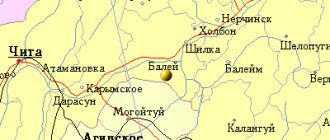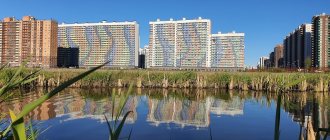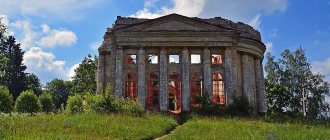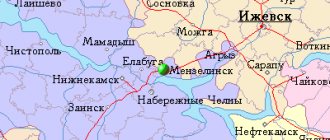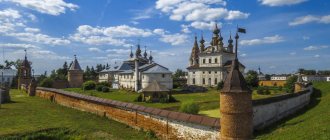| City Mamadysh Mamadysh Coat of arms |
| A country | Russia, Russia |
| Subject of the federation | TatarstanTatarstan |
| Municipal district | Mamadyshsky |
| urban settlement | Mamadysh city |
| Coordinates | 55°42′00″ n. w. 51°24′00″ E. d. / 55.70000° n. w. 51.40000° E. d. / 55.70000; 51.40000 (G) [www.openstreetmap.org/?mlat=55.70000&mlon=51.40000&zoom=12 (O)] (Z)Coordinates: 55°42′00″ N. w. 51°24′00″ E. d. / 55.70000° n. w. 51.40000° E. d. / 55.70000; 51.40000 (G) [www.openstreetmap.org/?mlat=55.70000&mlon=51.40000&zoom=12 (O)] (I) |
| Chapter | Ivanov Anatoly Petrovich |
| Based | in 1391 |
| City with | 1781 |
| Center height | 60 |
| Population | ↗15,573[1] people (2016) |
| Names of residents | mamadyshtsy, mamadyshtsy |
| Timezone | UTC+3 |
| Telephone code | +7 85563 |
| Postcode | 422190, 422191, 422192 |
| Vehicle code | 16, 116 |
| OKATO code | [classif.spb.ru/classificators/view/okt.php?st=A&kr=1&kod=92238501000 92 238 501 000] |
Show/hide cards
| Mamadysh Moscow |
| Kazan Mamadysh |
Audio, photo and video
on Wikimedia Commons
K:Settlements founded in 1391
Mamadysh
(Tat. Mamadysh) is a city (since 1781) in Russia, the administrative center of the Mamadysh district of Tatarstan.
Story
An ancient Bulgar settlement in the vicinity of Mamadysh appeared at the beginning of the 12th century. It is mentioned as “Ak Kirmen”, “White Kirmeni”, which in an adequate translation into Russian is “White Fortress” in 1151 in the annals of Kievan Rus... It is well known that the fortified settlement of Kermenchuk in the XII-XIV centuries was the center of the appanage principality of the Volga- Kama Bulgaria, completely independent. And until recently, the remains of its walls were located 18 kilometers from modern Mamadysh, not far from the village of Russian Kirmeni.
After the capture of Kazan by Ivan the Terrible in 1552 and with the inclusion of the Mamadysh lands into the Russian state, from the second half of the 16th century, Russian settlements began to emerge in the lower reaches of the Vyatka and Kama rivers. Since the end of the 16th century, the word “Mamadysh” appears in written sources.
On July 3, 1613, an official document was signed “On the formation of the monastic village of Trinity-Mamadysh on the site of the old Mamadysh wasteland,” which was part of the Kazan voivodeship, and then became part of the Kazan province as the center of the Mamadysh district. Soon, “on July 10, 1617, Archimandrite Cornelius of the Zainsky Monastery was allowed to build a fortress in the village of Mamadysh, on the Nokrat River, to protect against Nogai raids.”
History of Mamadysh and Mamadysh district
According to the population census in 1764 in the village of Troitsky, in Mamadysh there were only 139 households with a population of 545 people of both sexes. Here was the monastery courtyard, the wooden Nikolskaya Church, built in 1614, and a mill on the Oshma River. Since 1764, Mamadysh has been an economic village and, accordingly, its inhabitants are state peasants. This transfer of residents from one category to another, of course, did not make their fate easier. The situation of the Muslim Tatars became even more difficult, who, unlike the Kryashen Tatars, in addition to paying increased taxes to the state/necks, were required to perform additional duties. Teak since 1718, when, according to the Decree of Peter the Great, the Admiralty was established in Kazan, for example, from every ninth household of the Muslim Tatars, one horse and one foot worker was taken to harvest ship timber, popularly nicknamed “lashmans” and included under this name in many sorrowful ballads and bytes of the Tatar people. This work was hellish, many died from cold, hunger, disease... Russians and baptized Orthodox Tatars were not assigned to ship work. In the Mamadysh region, from the middle of the 18th century, traces of class stratification were clearly visible, which occurred both among the Tatars and among the Russians, Mari, Chuvash, Udmurts... But the February and then the October revolutions broke out. In the district city, as elsewhere in Russia, political struggle was in full swing. In the history of Mamadysh of those times, the representative of the Provisional Government, the right-wing Socialist Revolutionary A.D. Bilkzhovich, left a noticeable mark; Bolshevik, pro-gymnasium teacher V.V. Abramov; Chairman of the district Council of Peasants' Deputies, left Socialist Revolutionary I. R. Stepanov and others. The day of December 12, 1917 went down in the history of Mamadysh as the day of the establishment of Soviet power. Alexander Vasilyevich Davydov was elected the first chairman of the Bolshevik Council of Workers', Soldiers' and Peasants' Deputies. On the same day, the city government and the district zemstvo dispersed. However, no one was going to peacefully transfer power into the hands of the Bolsheviks. In the summer of 1918, civil war broke out. In May 1918, there were 110 people (company) among the Red Army volunteers in the district. At the same time, a district military registration and enlistment office was formed headed by A.V. Davydov. Trofim Gavrilovich Dazhin (later the chairman of the Naberezhnye Chelny city executive committee, and then a professor), Stepan Vasilyevich Domolazov (later a red general, division commander), Shamsi Sharafutdinovich Khisamutdinov and others actively worked as part of the military commissariat. But some of the Mamadyshites were on the side of the White Guard, in particular in the detachment of Staff Captain Leonid Shcherbakov, the son of the owner of a local distillery, who fought here. In the summer of 1918, the White Czechs and White Guards captured the city and carried out punitive actions, the victims of which were buried in a mass grave on Mount Puzanka (Mountain of Heroes). Next to the obelisk erected by those who died at the hands of the White Czechs, there is another obelisk - to those who died during the liberation of the city from the White Guards and White Czechs in the September days of 1918 by the soldiers of the 28th Azin Division. Peaceful construction began. But it did not last long - the civil war again dragged the Mamadysh region into its inferno. In mid-1919, Kolchak’s army captured the territory of modern Tatarstan, and Mamadyshsky district was declared front-line, and the front line ran along the Vyatka River. Here the Revolutionary Committee is created, to which all power is transferred and the general mobilization of those liable for military service into the Red Army is carried out. At the same time, despite the muddy roads, the peasants of the county presented about 10 thousand carts to the front for the evacuation of institutions, cars, cargo, and precious property. The Ukom of the RCP (b) issued a resolution to mobilize 70 percent of its communists to the front. So, in a short time, a detachment of 600 bayonets was formed from communists and volunteers by former non-commissioned officer S.V. Domolazov, which received the name “Mamadysh Communist Battalion”. Domolazov himself became the battalion commander, and Timofey Ivanovich Artemyev became the commissar. Then this battalion grew into the 39th regiment of the Azin division, which was skillfully commanded by the same Domolazov Stepan Vasilyevich - a hero of the civil war, one of those few who were awarded three Orders of the Red Banner of Battle for military merits. Until May 24, 1919, the front line for a long time ran along the Vyatka River - from Sokoliye Gory to Vyatskiye Polyany. The strip from Sokolki to Mamadysh was held by Azin’s division: the 39th regiment held the defense near the village of Grokhan, and the regiment of nineteen-year-old V.I. Chuikov (future commander, Marshal of the Soviet Union) was located in the city of Mamadysh. The headquarters of the 3rd brigade, brigade commander Gonikhin, was also located here. Divisional commander Azin and divisional commissar Pylaev often visited the brigade headquarters. In revenge for the events of the civil war, many streets in the city are named after the heroes of those days - Davydov, Azin, Domolazov, Chapaev, Krasnoarmeyskaya and others. The May offensive of 1919 was crowned with success by the Red Army and military skirmishes were never heard again on the streets of Mamadysh. Peaceful life began in the district.
In 1922, the county was renamed a canton, and in 1930 it began to be called a district, but with changed borders. The Mamadysh residents, as always, actively participate in the life of the country: this is eloquently evidenced by the fact that more than 13 thousand people fought on the fronts of the Great Patriotic War, of which every fourth died a heroic death. Gafiyat Nigmatullin, Ivan Maksimov, Mikhail Moskvin, Mikhail Prosvirnin, Pyotr Vorobyov were awarded the title of Hero of the Soviet Union. Five people - Kh. Valeev, V. Voznesensky, A. Kadyrov, M. Zainullin, M. Ignatiev were awarded the Order of Alexander Nevsky, and M. Khristoforov - the Order of Kutuzov. Unfortunately, many prominent people of the Mamadysh region were repressed in the 1930-50s, among them S.V. Domolazov, and A.V. Domolazov, and M.Kh. Budaili and others. By the way, on August 30, 1993, a monument was unveiled to the writer and journalist Mahmut Budaili in his native village of Shadchi. Mamadysh of the war years was deep in the rear. Entire institutions and industrial enterprises of other cities were evacuated here. So, in Mamadysh there was an orphanage near Moscow and a cotton factory, in Sokolki and Takanysh - Leningrad secondary schools. By the spring of 1944, the Mamadysh cotton factory began producing products for the front. The oldest enterprise in Mamadysh, the distillery, also worked for the front. The staff of this plant were the first in the region to take up the words of almost Gorky residents: “Work for yourself and your comrade who has gone to the front!” The villages also worked under the same motto during the war. In December 1941, courses for tractor drivers were created in Mamadysh, and by the spring of next year they had already trained more than 80 girls. On state farms and at MTS, women's brigades are formed. And yet, the workers of the region participated with great enthusiasm in all forms of the national movement to help the front - in creating a defense fund, collecting funds for armaments of the Red Army, and subscribing for a war loan. They collected warm clothes for those in the trenches and sent them parcels, often taking away from their meager table. Thus, by March 1942, workers of the Mamadysh rear contributed more than 263 thousand rubles to the Motherland Defense Fund, purchased government loan bonds for more than 167 thousand and a cash and clothing lottery for 270 thousand rubles. Gifts were sent to the fighters every holiday. The workers of the region collected over 3 million rubles for the construction of the “Collective Farmer of Tatarstan” tank column. Thus, residents of Verkhneyakinsk, Kuyukeryksinsky and Malmyzh village councils contributed 100 thousand rubles to this fund. Sabir Salimov, Mubaraksha Mukhamedshin, Shakur Ganeev from the villages of Khasanshina and Verkhnyaya Yaki transferred 5 thousand rubles each to the fund for the construction of a tank column. All three received personal telegrams of gratitude from Supreme Commander-in-Chief Stalin. In the same terrible year of 1943, at the expense of the workers of the region, airplanes were built for the aviation unit “Mamadyshsky Kolkhoznik”. And again from I.V. Stalin received a telegram: “Please convey to the workers of the Mamadysh district, who collected 2 million (actually 2,228 thousand rubles were collected - Author) for the construction of the Mamadysh Collective Farmer combat aircraft, my fraternal greetings and gratitude to the Red Army.” Aircraft for the Mamadyshsky Kolkhoznik aviation unit were manufactured at the Kazan plant named after S.P. Gorbunov.
Economy
Milk, cottage cheese, and other products are produced. There is also a hotel in the city.
The city has enterprises for the production of dairy products and meat products, and a brick factory.
There is an industrial park "Vyatka"[21], the residents of which are LLC "PC "Success" (Processing of agricultural products (vegetables, berries, honey), deep freezing, canning, packaging, storage), LLC "PC "MEGA AGROPROM CENTER" ( deep processing of meat, fish, canning, storage, packaging) and FAGRECO-Povolzhye LLC (production of agricultural plant protection products, ensuring the safety of feed and preparations for livestock).
Description of the region Mamadysh district occupies part of the lands of ancient Bulgaria on the banks of the Kama and Vyatka rivers. The district was formed in 1931. After the liquidation of the Takanysh district in 1961, part of it joined the Mamadysh district, and it became the largest district in the republic (2.6 thousand sq. km). photo www.old.mamadysh-rt.ru
The territory of the Mamadyshsky district is located in the eastern part of the Russian Plain, in the northeast of Tatarstan. In the east it borders with the Elabuga region, in the south with Nizhnekamsk and Chistopol, in the west with Tyulyachinsky and Sabinsky, in the north with Kukmorsky districts, and in the northeast with Udmurtia. Mamadyshsky district is located very close to the Kirov region. photo www.info-islam.ru
The area of the district is 2.6 thousand square meters. km. The natural border of the region in the east is the Vyatka River, in the west - the Kama River. The location of Mamadyshsky district is convenient in economic and geographical terms. Navigation on the Vyatka and Kama rivers and the Kazan-Naberezhnye Chelny highway favor economic relations with distant and near regions. The distance to Kazan is 167 km, to Naberezhnye Chelny - 87 km, to Kukmor - 80 km. Population: 42 thousand 021 people.
Industry The main industrial enterprises of the Mamadysh district are located in the regional center. Mamadysh Distillery - produces vodka, alcohol, dry feed yeast. photo by Mamadysh. rt
Mamadyshsky cheese and butter-making plant - cheeses and whole milk products. Mamadyshsky RaiPO produces bakery, pasta, confectionery, smoked products, and is engaged in procurement activities. Sausages from small business representative R.M. Mutigullina is implemented not only in the Republic of Tatarstan, but also beyond its borders. CJSC Stroyservis (Mamadysh Brick Factory) is the largest enterprise in the construction industry.
The base of the Mamadysh and Kama forestry enterprises is fundamental in the development of the woodworking industry.
Agriculture Agriculture in the region is diversified. It includes the production of grain, industrial crops and feed; livestock farming consists of meat and dairy, pig farming, beekeeping, fur farming, and poultry farming. Crop production is the basis of agriculture. Wheat, rye, buckwheat, barley, peas and other agricultural crops are grown in the area. photo komanda-k.ru/
The area of agricultural land in the district is 132 thousand hectares, including 88.8 thousand hectares of arable land. Livestock farming is an important industry in the region. It is based on keeping cattle. Pig farming is also profitable. The agricultural sector specializes in fur farming. Agricultural production is carried out by 15 agricultural enterprises of various forms of ownership, 53 farms. The largest enterprises in the region are Agro LLC, Agro LLC, Agro CJSC and others. The private sector occupies an important place in the production of agricultural products.
Education Now in the region there are 68 general educational institutions (46 - Tatar, 6 - Tatar-Russian, 13 - Russian, 1 - Udmurt, 1 - Mari), 1 - evening (shift) general education school, 1 - correctional boarding school, 1 agricultural lyceum and 1 vocational college. Over 5.4 thousand children study there. More than 1.6 thousand children are educated in 44 children's educational institutions (30 Tatar, 13 Russian, 1 Mari kindergarten). 85% of teachers have higher education, 15% have secondary specialized education. Also in the region, educational activities are carried out by 1 institution of additional education. photo tatfrontu.ru
Culture There are 138 institutions in the region, including 38 rural Houses of Culture, 37 rural clubs, 1 Mamadyshsky District House of Culture, 54 libraries, 4 museums, 1 children's art school (with two branches), 2 mobile clubs, 3 clubs operate theater and 4 ensembles, 1 park of culture and recreation named after. 60th anniversary of the Victory.
Coat of arms of the Mamadysh municipal district “In a green field above a wavy extremity, wavyly crossed with silver and azure (blue, light blue) - a golden sheaf of grain tied with a scarlet (red) ribbon between two facing silver sickles.”
The coat of arms of the Mamadysh district was developed on the basis of the historical coat of arms of the county town of Mamadysh, Kazan province, Supremely approved on October 18, 1781, the original description of which reads: “ In the upper part of the shield there is the Kazan coat of arms, in the lower part there are two silver sickles and in the middle there is a golden sheaf of wheat in green floor, as a sign of the abundance of this country with all kinds of life .”
The green color of the field symbolizes nature, hope, spring and health. The golden sheaf is a traditional symbol of unity of strength and spiritual aspirations, fertility and wealth. The sheaf, tied with a red ribbon, also allegorically indicates the inextricable connection between the urban and rural settlements that make up the region. Gold is a symbol of wealth, strength, generosity, stability. Red color is a symbol of strength, courage, labor, beauty and celebration.
Silver sickles symbolize the agricultural focus of the Mamadysh region and the hard work of its population. Water resources play a huge role in the life of the area, which is reflected by the blue tip and silver wavy belt. The blue tip symbolizes the river. Kamu and other small rivers. Blue color is a symbol of honor, nobility, spirituality. The silver belt allegorically points to the river. Vyatka: one of the names of Vyatka - Nokrat - translated from the Tatar language means “silver river”. Silver is a symbol of purity, perfection, peace and mutual understanding.
Approved by decision of the Council of the Mamadysh Municipal District dated November 2, 2006 No. 10−8. Included in the State Heraldic Register of the Russian Federation under No. 2734. Included in the State Heraldic Register of the Republic of Tatarstan under No. 80.
Flag of the Mamadysh municipal district “The flag of the Mamadysh municipal district is a rectangular panel with a width to length ratio of 2:3, consisting of three horizontal stripes: green (overall width 7/9 of the width of the panel), wavy white - 1/10 of the width, and blue; in the middle of the green stripe there are figures of the district’s coat of arms: a yellow sheaf tied with a red ribbon and two white sickles on the sides, with their points towards the sheaf.”
The flag of the Mamadysh district was created taking into account the coat of arms, which was developed on the basis of the historical coat of arms of the district town of Mamadysh, Kazan province, Supremely approved on October 18, 1781. The true description of the historical coat of arms reads: “In the upper part of the shield is the Kazan coat of arms, in the lower part there are two silver sickles and in the middle “There is a golden sheaf of wheat in a green floor, as a sign of the abundance of this country with all kinds of life.”
Author's group: the development of the coat of arms and flag was carried out by the Heraldic Council under the President of the Republic of Tatarstan together with the Union of Heraldists of Russia consisting of: Ramil Khairutdinov (Kazan), Radik Salikhov (Kazan), Ilnur Minnulin (Kazan), Konstantin Mochenov (Khimki), Kirill Perekhodenko (Konakovo) ), Yuri Korzhik (Voronezh), Oksana Afanasyeva (Moscow), with the participation of Pavel Smirnov (Mamadysh) and Ramil Minikhanov (Mamadysh).
Approved by decision of the Council of the Mamadysh Municipal District dated November 2, 2006 No. 11−8. Included in the State Heraldic Register of the Russian Federation under No. 2735. Included in the State Heraldic Register of the Republic of Tatarstan under No. 81.
Educational institutions
- Mamadysh secondary school No. 1.
- Lyceum No. 2 named after academician K.A. Valiev of the city of Mamadysh.
- Secondary school No. 3 of the city of Mamadysh.
- Secondary school No. 4 in Mamadysh.
- Mamadysh Polytechnic College.
- Children's art school of the city of Mamadysh named after the composers Yarullins (see Yarullin, Zagidulla Yarullovich, Yarullin, Farid Zagidullovich and Yarullin, Mirsaid Zagidullovich).
- Republican specialized children's and youth sports school for wrestling.
- Children's and youth sports school "Olympus".
- Children's and youth sports school for ice hockey and figure skating.
Mamadysh
(Republic of Tatarstan)
OKATO code:
92238501
Founded: City since:
1781 City of district subordination (Mamadysh district of the Republic of Tatarstan)
Center:
Mamadysh district
Telephone code (reference phone)
| 85563***** | 31-00-9 |
Deviation from Moscow time, hours:
0
Geographic latitude:
55°42′
Geographic longitude:
51°24′
Altitude above sea level, meters:
60 Sunrise and sunset times of the Sun and Moon in the city of Mamadysh
Links
Moscow (0—16)¹
Moscow region: Reutov (16) | Balashikha (16-30) | Old Kupavna (36—37) | Obukhovo (42—44) | Noginsk (50-60)
Vladimir region: Pokrov (103) |
Cockerels (121) | Lakinsk (150) | Vladimir
(180—192) | Vyazniki (291) | Gorokhovets (330)Nizhny Novgorod region: Dzerzhinsk (384, 402) | Nizhny Novgorod
(414) | Kstovo (440) | Lyskovo (502)
Chuvashia: Cheboksary
(651) |
Kugesi
(660) | Tsivilsk (683)Tatarstan: Kazan
(820) | Yelabuga | Naberezhnye Chelny (1055) | Menzelinsk
Bashkortostan: Verkhneyarkeyevo
(1193) |
Durtyuli | Kushnarenkovo
|
Ufa
(1342)see further: M-5 "Ural"
¹ The number in brackets indicates the distance from the center of Moscow in kilometers: to the Nizhny Novgorod region - according to topographic maps, then - according to a GPS map.
Map
| Mamadysh: cards |
Mamadysh: photo from space (Google Maps) Mamadysh: photo from space (Microsoft Virtual Earth)
| Mamadysh. Nearest cities. Distances in km. on the map (in brackets along roads) + direction. Using the hyperlink in the distance , you can get the route (information courtesy of the AutoTransInfo website) | |||
| 1 | Nizhnekamsk | 27 (124) | IN |
| 2 | Kamskie Polyany | 29 (171) | YU |
| 3 | Elabuga | 40 (59) | IN |
| 4 | Grakhovo (Udmurt Republic) | 52 (159) | NE |
| 5 | Zainsk | 59 (149) | SE |
| 6 | Chistopol | 60 (177) | SW |
| 7 | Vyatskiye Polyany | 61 (73) | WITH |
| 8 | Mendeleevsk | 61 (81) | IN |
| 9 | Sosnovka | 61 (88) | WITH |
| 10 | Kukmor | 62 (60) | NW |
| 11 | Krasnaya Polyana (Kirov region) | 62 (80) | WITH |
| 12 | Naberezhnye Chelny | 62 (80) | IN |
| 13 | Kizner (Udmurt Republic) | 65 (202) | WITH |
| 14 | Rich Subs | 69 (98) | NW |
| 15 | Novosheshminsk | 71 (210) | YU |
| 16 | Tyulyachi | 75 (77) | Z |
| 17 | Shemordan | 83 (119) | NW |
| 18 | Rybnaya Sloboda | 84 (101) | Z |
| 19 | Alnashi (Udmurt Republic) | 85 (119) | NE |
| 20 | Sarmanovo | 90 (137) | SE |
| 21 | Alekseevskoe | 93 (145) | SW |
| 22 | Mozhga | 97 (157) | NE |
| 23 | Malmyzh | 101 (130) | NW |
| 24 | Aksubaevo | 101 (242) | SW |
| 25 | Baltasi | 103 (139) | NW |
| 26 | Arsk | 105 (101) | NW |
| 27 | Almetyevsk | 105 (206) | SE |
| 28 | Menzelinsk | 106 (137) | IN |
| 29 | Pestretsy | 109 (122) | Z |
| 30 | Lower Maktama | 112 (199) | SE |
a brief description of
Located in the Kama region, 80 km southeast of the railway. Kukmor station, 167 km east of Kazan. Pier on the right bank of the Vyatka (tributary of the Kama).
Territory (sq. km): 15
Information about the city of Mamadysh on the Russian Wikipedia website
Historical sketch
It emerged as the Tatar village of Mamadysh, named after the first settler. From the 17th century Russians also begin to settle in it, and after the construction of a temple in the name of the Holy Trinity in the village, it becomes the village of Trinity, Mamadysh too.
Since 1781, the district town of Mamadysh of the Kazan governorship (since 1796 - Kazan province).
In 1856, in the district town of Mamadysh, Kazan province, there was 1 church, 570 houses, 18 shops.
Economy
Cotton factory, shoe production and other enterprises.
Museums, galleries, exhibition halls
Museum of Local Lore in the village of Takanysh 422140, Republic of Tatarstan, Mamadyshsky district, Nizhny Takanysh
village Mamadysh Museum of Local Lore 422170, Republic of Tatarstan, Mamadyshsky district, Mamadysh, st. Sovetskaya, 12
Memorial Museum - Library of Shaikha Mannur 422140, Republic of Tatarstan, Mamadyshsky district, village. Tulbaevo
Farid Yarullin Museum 422170, Republic of Tatarstan, Mamadyshsky district, village. Little Sun
| Population by year (thousands of inhabitants) | |||||||
| 1856 | 3.7 | 1989 | 11.8 | 2006 | 13.9 | 2015 | 15.5 |
| 1897 | 4.2 | 1992 | 12.7 | 2007 | 14.0 | 2016 | 15.6 |
| 1913 | 5.9 | 1996 | 13.4 | 2008 | 14.1 | 2017 | 15.7 |
| 1931 | 2.3 | 1998 | 13.6 | 2010 | 14.6 | 2018 | 15.8 |
| 1939 | 7.7 | 2000 | 13.9 | 2011 | 14.4 | 2019 | 15.9 |
| 1959 | 9.0 | 2001 | 14.0 | 2012 | 14.7 | 2020 | 15.9 |
| 1970 | 9.7 | 2003 | 13.5 | 2013 | 15.2 | 2021 | 15.8 |
| 1979 | 10.3 | 2005 | 13.8 | 2014 | 15.3 | ||
Excerpt characterizing Mamadysh
“Vous ne me prenez pas en taken aback, vous savez,” he said. – Comme veritable ami j'ai pense et repense a votre affaire. Voyez vous. Si vous epousez le prince (it was a young man), - he bent his finger, - vous perdez pour toujours la chance d'epouser l'autre, et puis vous mecontentez la Cour. (Comme vous savez, il ya une espece de parente.) Mais si vous epousez le vieux comte, vous faites le bonheur de ses derniers jours, et puis comme veuve du grand... le prince ne fait plus de mesalliance en vous epousant, [You Don't take me by surprise, you know. Like a true friend, I have been thinking about your case for a long time. You see: if you marry a prince, then you will forever lose the opportunity to be the wife of another, and in addition, the court will be dissatisfied. (You know, after all, kinship is involved here.) And if you marry the old count, then you will be the happiness of his last days, and then... it will no longer be humiliating for the prince to marry the widow of a nobleman.] - and Bilibin let go of his skin. – Voila un veritable ami! - said the beaming Helen, once again touching Bilibip’s sleeve with her hand. – Mais c'est que j'aime l'un et l'autre, je ne voudrais pas leur faire de chagrin. Je donnerais ma vie pour leur bonheur a tous deux, [Here is a true friend! But I love both of them and I wouldn’t want to upset anyone. For the happiness of both, I would be ready to sacrifice my life.] - she said. Bilibin shrugged his shoulders, expressing that even he could no longer help such grief. “Une maitresse femme! Voila ce qui s'appelle poser carrement la question. Elle voudrait epouser tous les trois a la fois,” [“Well done woman! This is what is called firmly asking the question. She would like to be the wife of all three at the same time.”] thought Bilibin. - But tell me, how will your husband look at this matter? - he said, due to the strength of his reputation, not afraid to undermine himself with such a naive question. – Will he agree? - Ah! Il m'aime tant! - said Helen, who for some reason thought that Pierre loved her too. – Il fera tout pour moi. [Oh! he loves me so much! He is ready for anything for me.] Bilibin picked up the skin to indicate the preparing mot. “Meme le divorce, [Even for a divorce.],” he said. Helen laughed. Among the people who allowed themselves to doubt the legality of the marriage being undertaken was Helen’s mother, Princess Kuragina. She was constantly tormented by envy of her daughter, and now, when the object of envy was closest to the princess’s heart, she could not come to terms with this thought. She consulted with a Russian priest about the extent to which divorce and marriage was possible while her husband was alive, and the priest told her that this was impossible, and, to her joy, pointed her to the Gospel text, which (it seemed to the priest) directly rejected the possibility of marriage from a living husband. Armed with these arguments, which seemed irrefutable to her, the princess went to see her daughter early in the morning, in order to find her alone. After listening to her mother's objections, Helen smiled meekly and mockingly. “But it’s directly said: whoever marries a divorced wife...” said the old princess. - Ah, maman, ne dites pas de betises. Vous ne comprenez rien. Dans ma position j'ai des devoirs, [Oh, mamma, don't talk nonsense. You don't understand anything. My position has responsibilities.] - Helen spoke, translating the conversation into French from Russian, in which she always seemed to have some kind of ambiguity in her case. - But, my friend... - Ah, maman, comment est ce que vous ne comprenez pas que le Saint Pere, qui a le droit de donner des dispenses... [Ah, mamma, how do you not understand that the Holy Father, who has the power of absolution ...] At this time, the lady companion who lived with Helen came in to report to her that His Highness was in the hall and wanted to see her. - Non, dites lui que je ne veux pas le voir, que je suis furieuse contre lui, parce qu'il m'a manque parole. [No, tell him that I don’t want to see him, that I’m furious against him because he didn’t keep his word to me.] “Comtesse a tout peche misericorde, [Countess, mercy for every sin.],” said the young blond man as he entered. a man with a long face and nose. The old princess stood up respectfully and sat down. The young man who entered did not pay attention to her. The princess nodded her head to her daughter and floated towards the door. “No, she’s right,” thought the old princess, all her convictions were destroyed before the appearance of His Highness. - She is right; but how is it that we didn’t know this in our irrevocable youth? And it was so simple,” the old princess thought as she got into the carriage. At the beginning of August, Helen's matter was completely determined, and she wrote a letter to her husband (who loved her very much, as she thought) in which she informed him of her intention to marry NN and that she had joined the one true religion and that she asks him to complete all the formalities necessary for divorce, which the bearer of this letter will convey to him. “Sur ce je prie Dieu, mon ami, de vous avoir sous sa sainte et puissante garde. Votre amie Helene.” [“Then I pray to God that you, my friend, will be under his holy, strong protection. Your friend Elena"]
Population
Articles • Geography of Mamadysh
Population and its changes
47.3 thousand people live in the area. This is 1.5% of the population of Tatarstan. Density – 18.2 people per 1 sq. km ha. Birth rate is an average of 420 children per year (14.8%), mortality is 820 people (14.5%), 282 marriages are registered (31 mixed, 11%), natural increase is 0%.
The average life expectancy in the region is 53 years. 13.7 thousand people (28.9%) live in the city of Mamadysh, 33.6 thousand (71.1%) live in villages. The working population is 47.7%, youth – 25%, pensioners – 27.3%.
In recent years, the population growth in the region is associated with the migration process, and a decrease in the rural population has been observed. The rural population is declining on average by 370 people or 1% per year. Many villages disappeared: Kutushi, Kabyk Kuper, Astan Elga, Efremov Pochinok, Etbasmabas (Upper Shander), Copper Plant, Novaya Sun and others. Seven villages are on the verge of extinction. Below is the distribution of villages by number of households and residents:
| Number of farmsteads | to 10 | up to 50 | up to 100 | up to 500 | up to 100 | over 1000 |
| Number of villages | 14 | 38 | 42 | 59 | 6 | 1 |
| Number of village inhabitants | to 10 | up to 100 | up to 500 | up to 1000 | over 1000 | Total |
| Number of villages | 7 | 38 | 66 | 16 | 5 | 118 |
47.2% of the population are men, 52.8% are women. Families consist of an average of 3.5 people, each family has an average of 1.5 children.
The table below shows the natural growth for some SMS:
| SMS name | Fertility | Mortality | Difference | Growth per 1000 people |
| Takanyshsky Oluyazsky Ishkeevsky Sekinessky Klyaushsky Bersutsky Sunsky | 8 17 10 1 4 4 5 | 12 29 7 3 17 12 14 | -4 -12 -3 -2 -13 -8 -9 | -2 -7 -9,3 -10 -13 -16 -22,5 |
National composition of the population
The population of the area is multinational. 72.5% of all residents are Tatars, 24.2% are Russians, 1.4% are Mari, 1.3% are Udmurts. There are small numbers of Armenians, Azerbaijanis, Greeks, Ingush, Georgians, Ukrainians and representatives of other nations. Mostly Tatars live in rural areas. Many are leaving the countryside. Table of abandoned villages:
| No. | Village names | SMS name | Who lived |
| 1 2 3 4 5 6 7 8 | Kabyk Cooper Efremovka Nikolskoe Otarnoye Novaya Sun Kutushi Mulla Ile Verkhniy Shander | Tavelsky Klyaushsky Digitlinsky Digitlinsky Sunsky Sekinessky Kemeshkulsky Nizhneshandersky | Russian Russian Russian Russian Russian Russian Tatar Tatar |
The resettlement of Russians to the territory of the region began after 1613, with the transfer of land to the Zuysky monastery. Relocation table:
| № | Village names | Where did they move from? | Relocation date (year) |
| 1 | Alkino | Neighborhoods of Kazan | 1830 |
| 2 | Upper Artash | Lashmany | 1810 |
| 3 | Albaevo | Tyulyachi, Kumyryk | 1873 |
| 4 | Belyaev Klyuch | Red hill | 1809 |
| 5 | Birch Mane | lobster | 1810 |
| 6 | Vasilyevo | Sash (Vyatka province), Krasnaya Gorka (Elabuga), Belyaev Pochinok | 1809 |
| 7 | Gremyachka | Mamadysh | 1840 |
| 8 | Guryevka | Penza | 1837 |
| 9 | Efremovka | Krasnaya Gorka, Kamenny Pochinok | 1820 |
| 10 | Zyuri | Old Zyuri (Mesha) | |
| 11 | Tashliyar | Mochalkino | |
| 12 | Small Kirmeni | Village Koshar (Kazan province) | |
| 13 | Russian Kirmeni | Sarapul | |
| 14 | Vandovka | lobster | |
| 15 | Red hill | Novgorod, Vyatsk. lips | |
| 16 | Kulusheva wasteland | Sekines, Ostolokovo (Laishevo) | 1666 |
| 17 | Little Sun | Abdi | 1835 |
| 18 | Klyaushi | Mamadysh, Guryevka, Krasnaya Gorka, Lubyany, Arsk | 1795 |
| 19 | Sarbash | Klyaushi | 1852 |
| 20 | Toguz | Klyaushi | 1852 |
| 21 | Poikino | Poikino (Vyatka province) | |
| 22 | Mamadysh | Sviyazhsk | 1605 |
| 23 | Copper plant | Zlatoust | 1725 |
| 24 | Nikiforovo | Vladimir province | 1872 |
| 25 | Nikolskoye | Tula province | 1844 |
| 26 | Lobster | Kazan, Urazbakhtino | 16th century |
| 27 | Omarsky Pochinok | Perm province | 16th century |
| 28 | Otarka | Nurma, Komarovka (Laesh) | 1750 |
| 29 | Otarka Nizhnyaya | Villages of Mamadysh | |
| 30 | Chupayevo | Krasnaya Gorka, Otarka, Chekurchi (Kazan) | 1795 |
| 31 | Russian Pakshin | Red hill | 1825 |
| 32 | Postnikov Pochinok | Kukmor | 1875 |
| 33 | Ragozino | Sekines | 18th century |
| 34 | Sokolka | Pig Mountain (Vyatka province) | 1682 |
| 35 | Sekines | Village Kerzhenets (Nizhny Novgorod) | 16th century |
| 36 | Taveli | Vyatka province | 16th century |
| 37 | Tulbaevo | Tolly (Kukmorsky district) | |
| 38 | Urmancheevo | Beds | 18th century |
| 39 | Malmyzhka | Malmyzh (Ufa province) | 18th century |
| 40 | Chucks | Klyuchishchi (Laishevo), Moldova | |
| 41 | Kargali | Old Shiya | |
| 42 | Yakovka | Mamadysh | 1844 |
| 43 | Kirbash | Yanasal (Laishevo) | 1809 |
Muslim Tatars adhere to the Islamic religion, Russians, Kryashens, Mari and Udmurts adhere to Orthodoxy. In recent years, attention has increased to the construction and restoration of mosques and churches.
Added: August 13, 2007 | Views: 13284 | Rating: 5.0/1
| Total comments: 2 | |
| 0 Spam 1 Rafael • 16:05:30, February 23, 2008 [Material] We need to change something, raise the birth rate, develop the city and region, where are the leadership of the city and region looking? 0 Spam 2 Anonymous • 08:52:36, January 25, 2014 [Material] There are no conditions in the city, the loans are huge, the salary is insignificant...how can the common people live...the birth rate is out of the question...everything is neglected...it is not realistic to support a family on a salary of 6-7 thousand!!! | |
